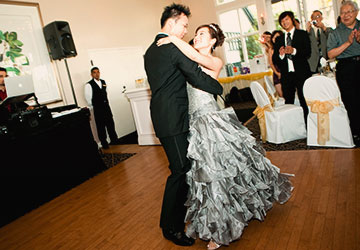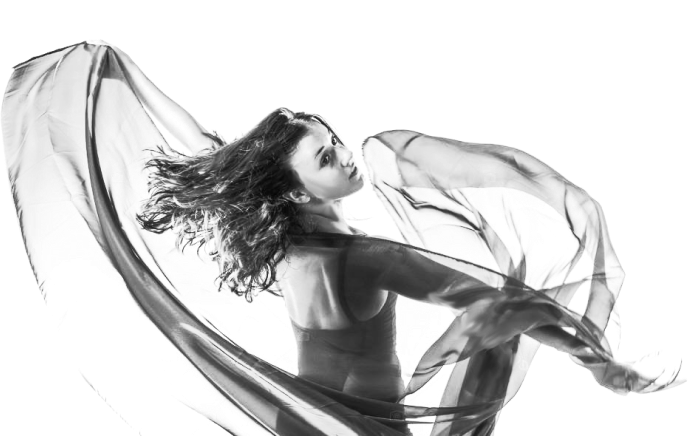
Ballroom Dancing
Waltz
The Waltz is a very popular social and wedding dance. It is characterized by an elegant “rise and fall,” turns, and gorgeous body sways. It is a fantastic Ballroom dance for new dancers and the Waltz is a beautiful style for a wedding first dance.
Waltz Dance History
The beginning of Waltz has several references from the 16th century. A French philosopher by the name of Montaigne wrote of a dance that he witnessed where the couple dancing and how they held each other so close that their faces were touching. These dances were seen as “godless” dances, and were performed mainly by the peasant populations.
By 1750, peasants of Bavaria, Tyrol, and Syria were dancing the Walzer (a Waltz-like dance.) At the same time, a similar dance known as the Landler was popular in Austria, Bohemia, and Bavaria. The Landler was spread from the countryside to the suburbs of the cities. Upper class citizens continued to dance the minuet, while noblemen began to get bored and to joined the balls of their servants.
When the Waltz was first introduced in Europe in the early 1800s, it was viewed as scandalous and “immoral” because of its very close dance embrace and its rapid turning movements. Despite the dance originally being associated with lower class servants and disgraceful movements, the Waltz quickly became part of popular culture in Europe. The Waltz spread from Germany to the dance halls of Paris as soldiers came back from the Napoleonic wars. In the mid-1800s, it was introduced to the United States. Early Waltz music was very fast (from it’s early days as an Austrian folk dance) with continuous twirling. Gradually, in the early 1900s, a slower style of Waltz dancing developed. This slower style of Waltz is what people call Waltz today. The faster style of Waltz is known as Viennese Waltz. The Viennese Waltz is technically the oldest of all current ballroom dances as it emerged from the earlier mentioned Landler dance. Both Waltz and Viennese Waltz were criticized for their “scandalous nature” at first, but both grew to be accepted as two of the most beautiful, classy, and embraced dance styles in the world.
While it is not clear exactly when the Waltz came to America, it is agreed that by the end of the 19th century the Waltz was considered an established party dance of the United States dance scene. American’s created their own variations of the dance including the “Boston Waltz” which slowed down the tempo of the music to favor the long, gliding dance steps and scarcer circular motions. American style ballroom dancers developed Waltz dancing with open dance positions in addition to only being done in closed dance position. The dancers’ legs in the American style crossed each other with each step as opposed to closing together. These stylistic variations have remained part of the Waltz to the present. The “Hesitation Waltz” also developed in the United States, but did not stand the test of time like the Boston Waltz and Viennese Waltz. This slower paced Waltz never became as popular as the Waltzes that are dance today.
Waltz Dancing Today
The Waltz continues to be one of the most popular social dances, especially for ballroom dance fans and marrying wedding couples. The Waltz is also used as a competitive dance style. It has been seen on popular National dance shows such as “Dancing With the Stars” and “So You Think You Can Dance”.
The Waltz is both danced and used to compete in both American style and International style of ballroom dancing. In American style ballroom dancing, Waltz is considered a “smooth” dance along with Tango, Viennese Waltz, Tango and Foxtrot. Waltz in American Style ballroom dance is done in both open and closed dance positions so that the dancers are free to separate from one another. An example of a move that is done as an open dance figure in American Standard Waltz is the syncopated side-by-side with spin. This move includes a free spin for both partners. The Open Roll is another figure that involves open frame that won’t be found in International style Waltz. In this move, the follower alternates between the leads left and right sides with the leads left arm or right arm providing the lead. The Waltz became the staple of many American films and musicals including “Waltz in Swing Time” which was sung by Fred Astaire in 1936.
International style dancing is danced is closed position for all the standard dances. Waltz is considered a “standard” dance alongside Tango, Viennese Waltz, Foxtrot, and Quickstep. In standard dance closed position, the follow’s right hand is on the leads left and the follows left hand is on the leads right shoulder with the leads right hand on the follows shoulder blade.
All ballroom dancers today will recognize the basic Waltz pattern as a step, a slide, and a step in ¾ time. Partners dancing a Waltz keep their shoulders parallel to the floor instead of vertical. The steps strive to be lengthened with heel leads on the forward steps and toe leads on the steps to the back and side.
Waltz Dance Music:
- “Come Away With Me” Norah Jones
- “Open Arms” Journey
- “Take It To the Limit” Eagles
- “Could I Have This Dance” Anne Murray
- “True Love” Elton John
- “Fascination” Nat King Cole
- “A Time for Us (Romeo and Juliet)” Andy Williams
- “Rainbow Connection” Kermit the Frog
- “Dark Waltz” Haley Westenra
- “Here We Go” Jon Brion
- “Gravity” John Mayer
- “You and Me” Lifehouse
- “If I Knew Then” Lady Antebellum
- “First and Last Waltz” Nickel Creek
- “Never Tear Us Apart” INXS
- “I Won’t Give Up” Jason Mraz
- “Look Through My Eyes” Phil Collins
- “With You I’m Born Again” Billy Preston
- “If I Could Turn Back the Hands of Time” R. Kelly
- “You Light Up My Life” Debby Boone
- “She’s Always a Woman” Billy Joel
- “Weekend in New England” Barry Manilow
- “Queen of My Heart” Westlife
- “If I Ain’t Got You” Alicia Keys
- “Break Up to Make Up” The Stylistics
- “Only One Road” Celine Dion
- “Funny Familiar Forgotten Feelings” Tom Jones
- “Caribbean Blue” Caribbean Blue
- “Still Crazy After All These Years” Paul Simon
- “I Wonder Why” Curtis Stigers
- “Nothing Else Matters” Metallica
- “Moon River” Audrey Hepburn
- “Kiss From a Rose” Seal
- “Are You Lonely Tonight” Elvis Presley
- “What the World Needs Now” My Best Friends Wedding
- “Weekend in New England” Barry Manilow
- “Cry” Faith Hill
- “Body and Soul” Anita Baker
- “Drift Off to Dream” Travis Tritt
- “When I Said I Do” Clint Black
- “If You Don’t Know Me By Now” Simply Red


